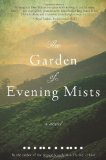Summary | Excerpt | Reviews | Beyond the Book | Read-Alikes | Genres & Themes | Author Bio

This article relates to The Garden of Evening Mists
The Japanese gardener Nakamura Aritomo in The Garden of Evening Mists is an accomplished ukiyo-e artist. This art form, like most others, was a product of time and place but ukiyo-e was especially so.
Hundreds of years ago (1615-1868) the Tokugawa shoguns ruled Japan according to a strict class-based, hierarchical society. They made Tokyo (then known as Edo) their capital and the city grew to be a thriving and vibrant one. The Tokugawa placed warriors such as themselves first, followed by farmers, artisans and merchants. The artisans and merchants were considered lower classes and were subject to severely repressive laws that governed how they dressed and lived. The shoguns understood, however, that the merchant class was a particularly thriving one and that the lower classes would need some kind of escape to prevent unrest from fomenting against established order. This "escape" took the form of a vibrant theater and brothel district in Edo, a "floating world" that catered to the oppressed classes in Edo.
This theater (kabuki) and brothel district (yoshiwara) in Edo provided the inspiration for much of the early works of ukiyo-e - literally translated as "pictures of the floating world." In their early stages, ukiyo-e were created to advertise local theater performances and even to flaunt the prettiest women in the brothels. Ukiyo-e were also used as book illustrations.
This art form was unique because it could be mass-produced, so most people could afford a print made on a scroll to hang in their homes. Prints were often put up on walls and sliding doors or on folding screens. Also while the creator of the original drawing was recognized as the primary artist, the final print was a collaboration between the artist, the woodblock cutter and the production studio which generated the prints. The artist created the original drawing, the woodcutting artist recreated it on a block of wood using very fine tools, and then prints were created using available colors.
As ukiyo-e gained in popularity, the art form began to explore images outside the "floating world." A national love of nature and landscape began influencing the medium and some of the most dramatic ukiyo-e images are those of landscapes. Of particular note is "Thirty-six Views of Mount Fuji" by artist Katsushika Hokusai. It can be argued that one particular print, "The Great Wave off Kanagawa", from this series is the most instantly recognizable image of Japanese art. 
Ukiyo-e had a great influence on Western art. The Dutch artist, Vincent van Gogh, had a private collection and attributes of Japonisme (a style of art with Japanese elements) can be seen in some of his paintings. At the same time, Western influences were also apparent in ukiyo-e - prints such as "Western Traders at Yokohama" and "Prosperous America" allow us to see the west through the Japanese ukiyo-e perspective.
While ukiyo-e as a popular art form started fading in the nineteenth century, Japanese and other artists have continued to apply its principles (including its strong reliance on fantasy) to their art. Nakamura Aritomo, in The Garden of Evening Mists, used the principles of ukiyo-e to create art designed to memorialize his native country.
Ukiyo-e can be viewed in museums and galleries around the world including in Japan, Britain and the United States. The Library of Congress has an extensive collection.
![]() This article relates to The Garden of Evening Mists.
It first ran in the October 17, 2012
issue of BookBrowse Recommends.
This article relates to The Garden of Evening Mists.
It first ran in the October 17, 2012
issue of BookBrowse Recommends.
Your guide toexceptional books
BookBrowse seeks out and recommends the best in contemporary fiction and nonfiction—books that not only engage and entertain but also deepen our understanding of ourselves and the world around us.